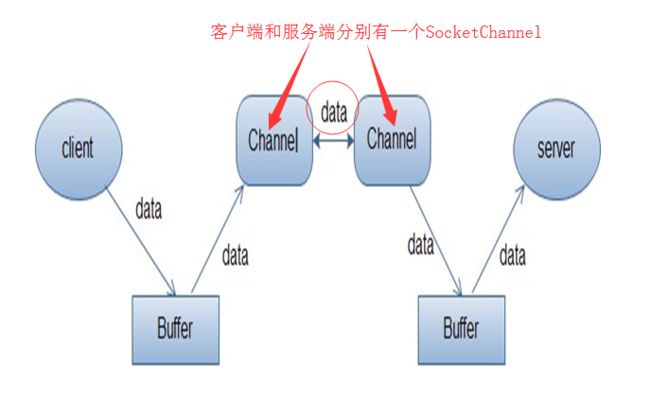java通过NIO实现时间服务器
NIO客户端以及服务端通信流程图
解读流程图
1、客户端和服务端通信是通过SocketChannel(包含ByteBuffer),且客户端和服务分别一个SocketChannel对象。
2、客户端与服务端都是从ByteBuffer读取/写入数据。
NIO开发时间服务器大致流程
服务端
1、新开一个线程,打开ServerSocketChannel并设置为非阻塞模式,监听一个端口,新建一个多路复用器Selector,将ServerSocketChannel注册到Selector并监听客户端的连接请求。
2、循环selector,将注册到上面的SelectionKey遍历出来,
如果是连接事件,将客户端SocketChannel注册到Selector,并设置为非阻塞,并监听可读状态。
如果是可读事件将用SocketChannel.read(ByteBuffer)将socketChannel里的数据读入到ByteBuffer里。再将ByteBuffer里的数据写入到字节数组。这样在向客户端写入数据时将字节数组的数据通过SocketChannel写入到ByteBuffer,从而完成写入客户端。
客户端:
1、通过SocketChannel.open()打开SocketChannel,通过Selector.open()打开多路复用器Selector,设置SocketChannel为非阻塞。
2、连接服务端boolean connect = socketChannel.connect(new InetSocketAddress(host, port));如果连接成功则将
socketChannel.register(selector, SelectionKey.OP_READ);socketChannel的可读事件注册到多路复用器。如果没有连接成功
socketChannel.register(selector, SelectionKey.OP_CONNECT);socketChannel的连接事件注册到多路复用器。
3、轮询多路复用器上的事件SocketChannel client = (SocketChannel) selectionKey.channel();
获取客户端SocketChannel,如果连接成功则SocketChannel注册到Selector,注册SelectionKey.OP_READ操作位。这时再向服务端写入数据(将数据通过SocketChannel写入到ByteBuffer)。
4、在通过轮询时判断selectionKey.isReadable()代表客户端收到服务器端的应答消息,则将服务端发送的数据写入到ByteBuffer,再将ByteBuffer里的数据写入到字节数组。
NIO优点
1、
客户端发起的连接操作是异步的,可以通过在多路复用器注册OP_CONNECT等待后续结果,不需要像之前的客户端那样被同步阻塞;
2、
SocketChannel的读写操作都是异步的,如果没有可读写的数据它不会同步等待,直接返回,这样IO通信线程就可以处理其他的链路,不需要同步等待这个链路可用;
3、
线程模型的优化:由于JDK的Selector在Linux等主流操作系统上通过
epoll实现,它没有连接句柄数的限制(只受限于操作系统的最大句柄数或者对单个进程的句柄限制),这意味着一个Selector线程可以同时处理成千上万个客户端连接,而且性能不会随着客户端的增加而线性下降。
NIO缺点
1、NIO类库和API复杂,使用麻烦。
2、需要具备Java多线程编程能力(涉及到Reactor模式)。
3、客户端断线重连、网络不稳定、半包读写、失败缓存、网络阻塞和异常码流等问题处理难度非常大
4、存在部分BUG
服务端代码
import java.io.IOException;
import java.net.InetSocketAddress;
import java.nio.ByteBuffer;
import java.nio.channels.SelectionKey;
import java.nio.channels.Selector;
import java.nio.channels.ServerSocketChannel;
import java.nio.channels.SocketChannel;
import java.util.Date;
import java.util.Iterator;
import java.util.Set;
//单个线程处理请求
public class MultiplexerTimeServer implements Runnable {
private Selector selector;
private ServerSocketChannel serverChannel;
private volatile boolean stop;//注意这个变量volatile修饰
/**
* 构造函数
* @param port
*/
public MultiplexerTimeServer(int port) {
try {
//打开ServerSocketChannel
serverChannel = ServerSocketChannel.open();
//设置为非阻塞模式
serverChannel.configureBlocking(false);
//绑定监听的端口地址
serverChannel.socket().bind(new InetSocketAddress(port), 1024);
//创建Selector线程
selector = Selector.open();
//将ServerSocketChannel注册到Selector,交给Selector监听
serverChannel.register(selector, SelectionKey.OP_ACCEPT);
System.out.println("The time server is start in port:"+port);
} catch (Exception e) {
e.printStackTrace();
System.exit(1);
}
}
public void stop(){
this.stop = true;
}
@Override
public void run() {
while(!stop){
try {
//通过Selector循环准备就绪的Channel===>Key
selector.select();
Set selectionKeys = selector.selectedKeys();
Iterator iterator = selectionKeys.iterator();
SelectionKey selectionKey = null;
while(iterator.hasNext()){
selectionKey = iterator.next();
iterator.remove();
try {
handleInput(selectionKey);
} catch (Exception e) {
if(selectionKey!=null){
selectionKey.cancel();
if(selectionKey.channel()!=null){
selectionKey.channel().close();
}
}
}
}
} catch (Exception e) {
e.printStackTrace();
}
}
if(selector !=null){
try {
selector.close();
} catch (IOException e) {
e.printStackTrace();
}
}
}
private void handleInput(SelectionKey selectionKey) throws IOException {
//判断key是否有效
if(selectionKey.isValid()){
if (selectionKey.isAcceptable()) {
ServerSocketChannel server = (ServerSocketChannel) selectionKey.channel();
//多路复用器监听到新的客户端连接,处理连接请求,完成TCP三次握手。
//这个SocketChannel是和客户端进行通信的
SocketChannel client = server.accept();
//设置为非阻塞模式
client.configureBlocking(false);
// 将新连接注册到多路复用器上,监听其读操作,读取客户端发送的消息。
client.register(selector, SelectionKey.OP_READ);
}
if(selectionKey.isReadable()){
SocketChannel client = (SocketChannel) selectionKey.channel();
ByteBuffer receivebuffer = ByteBuffer.allocate(1024);
//读取客户端请求消息到缓冲区
int count = client.read(receivebuffer); //非阻塞
if (count > 0) {
receivebuffer.flip();
//remaining()方法返回Buffer中剩余的可读数据长度
byte[] bytes = new byte[receivebuffer.remaining()];
//从缓冲区读取消息
receivebuffer.get(bytes);
String body = new String(bytes, "UTF-8");
System.out.println("The time server(Thread:"+Thread.currentThread()+") receive order : "+body);
//将currentTime响应给客户端(客户端Channel)
String currentTime = "QUERY TIME ORDER".equalsIgnoreCase(body) ? new Date(System.currentTimeMillis()).toString() : "BAD ORDER";
doWrite(client, currentTime);
}else if(count < 0){
selectionKey.channel();
client.close();
}else{
}
}
}
}
private void doWrite(SocketChannel client, String currentTime) throws IOException {
if(currentTime != null && currentTime.trim().length()>0){
ByteBuffer sendbuffer = ByteBuffer.allocate(1024);
sendbuffer.put(currentTime.getBytes());
sendbuffer.flip();
//将客户端响应消息写入到客户端Channel中。
client.write(sendbuffer);
System.out.println("服务器端向客户端发送数据--:" + currentTime);
}else{
System.out.println("没有数据");
}
}
}
客户端代码
import java.io.IOException;
import java.net.InetSocketAddress;
import java.nio.ByteBuffer;
import java.nio.channels.SelectionKey;
import java.nio.channels.Selector;
import java.nio.channels.SocketChannel;
import java.util.Iterator;
import java.util.Set;
public class TimeClientHandler implements Runnable {
private String host;
private int port;
private SocketChannel socketChannel;
private Selector selector;
private volatile boolean stop;
public TimeClientHandler(String host, int port) {
this.host = host;
this.port = port;
try {
//打开SocketChannel
socketChannel = SocketChannel.open();
//创建Selector线程
selector = Selector.open();
//设置为非阻塞模式
socketChannel.configureBlocking(false);
} catch (Exception e) {
e.printStackTrace();
System.exit(1);
}
}
@Override
public void run() {
try {
doConnect();
} catch (Exception e) {
e.printStackTrace();
System.exit(1);
}
while(!stop){
//轮训通道的状态
try {
selector.select(1000);
Set selectionKeys = selector.selectedKeys();
Iterator iterator = selectionKeys.iterator();
SelectionKey selectionKey = null;
while(iterator.hasNext()){
selectionKey = iterator.next();
iterator.remove();
try {
handleInput(selectionKey);
} catch (Exception e) {
if(selectionKey!=null){
selectionKey.cancel();
if(selectionKey.channel()!=null){
selectionKey.channel().close();
}
}
}
}
} catch (Exception e) {
e.printStackTrace();
System.exit(1);
}
}
if(selector !=null){
try {
selector.close();
} catch (IOException e) {
e.printStackTrace();
}
}
}
private void handleInput(SelectionKey selectionKey) throws Exception {
if(selectionKey.isValid()){
SocketChannel client = (SocketChannel) selectionKey.channel();
if (selectionKey.isConnectable()){
if(client.finishConnect()){
client.register(selector, SelectionKey.OP_READ);
doWrite(client);
}else{
System.exit(1);
}
}
if (selectionKey.isReadable()) {
ByteBuffer receivebuffer = ByteBuffer.allocate(1024);
int count = client.read(receivebuffer);
if (count > 0) {
receivebuffer.flip();
byte[] bytes = new byte[receivebuffer.remaining()]; //remaining()方法
receivebuffer.get(bytes);
String body = new String(bytes, "UTF-8");
System.out.println("Now is "+body);
this.stop = true;
}else if(count < 0){
selectionKey.channel();
client.close();
}else{
}
}
}
}
private void doConnect() throws Exception {
//连接服务端
boolean connect = socketChannel.connect(new InetSocketAddress(host, port));
//判断是否连接成功,如果连接成功,则监听Channel的读状态。
if(connect){
socketChannel.register(selector, SelectionKey.OP_READ);
//写数据 写给服务端
doWrite(socketChannel);
}else{
//如果没有连接成功,则向多路复用器注册Connect状态
socketChannel.register(selector, SelectionKey.OP_CONNECT);
}
}
private void doWrite(SocketChannel channel) throws IOException {
ByteBuffer sendbuffer = ByteBuffer.allocate(1024);
sendbuffer.put("QUERY TIME ORDER".getBytes());
sendbuffer.flip();
//向Channel中写入客户端的请求指令 写到服务端
channel.write(sendbuffer);
if(!sendbuffer.hasRemaining()){
System.out.println("Send order to server succeed.");
}
}
} 